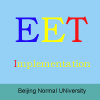-
Computer use in K-12 settings
普通类 -
- 支持
- 批判
- 提问
- 解释
- 补充
- 删除
-
-
Computer use in K-12 settings
TECHNOLOGY CAN HAVE A POWERFUL and profound impact on education and learning especially in the K-12 learning environment. However, even in the technology-rich 21st Century, researchers and curriculum designers still struggle with how to integrate technology in effective and authentic ways in order to support both teachers and students.-
Don't forget the teachers!
Teachers wear many "hats." We tend to define teachers primarily by what they do while inside the classroom. However, teachers do most of their work before they even face their students. Technology can provide the tools to make K-12 teachers more efficient at some of those out-of-class duties like grading papers, preparing curriculum and writing progress reports.
Full-time teachers often assume the role of part-time curriculum designer, part-time administrator and ever-improving professional. Table 1 describes some computer tools that support these out-of-class teacher roles:
Curriculum Designer Administrator Professional
Presentation software Spreadsheets for class rosters Online Portfolio
Digital Rubric Generators Grading Software Electronic Curriculum Vita
Online Lesson Resources and Examples Word Processing for school newsletters, letters to parents, etc. Personal web site
Online teacher workshopsTable 1: Out-of-class Teacher Roles
Good teachers work hard both inside and outside the classroom. What they do away the classroom ultimately affects what happens inside it. The better they are prepared for class, the better and more effectively they can run their class. It follows that any positive impact computers can have on their out-of-class duties can translate into a positive impact on what happens inside it. Every teacher should ask himself, "how can my computer make me a better teacher the moment I walk into my classroom."(Dockterman, 1998)-
What about Students?
Very few K-12 classrooms provide their students access a computer for an entire class period. However, this does not preclude effective computer use.
The One Computer Classroom
In the One-computer classroom, teachers can create a computer learning station. Typical classrooms already have specific areas designated for reading, art, math and science complete with appropriate learning materials. In this environment some students can engage in activities like art or math, while other students gather around the computer to perform research, print materials or prepare presentations to present later to the entire class.
In the one-computer classroom, the computer should not be just an expensive video game or reward for students who complete their work early. Instead it should be a resource that students see as a tool to meet their educational goals.-
When multiple computers are available.
If students have continued access to multiple computers, then educational technology takes on an amplified and enhanced flavor; a student-centered and project-based learning atmosphere can evolve. The key is to have the human infrastructure to support this environment. In the ideal technology structure, a computer educator and library media specialist are available to assist classroom teachers in providing compelling curriculum that leverages technology. Table 2 diagrams the partnership between teacher,media specialist and computer educator in creating a learning unit.

Table 2: Collaborative Curriculum Planning. Adapted from work published by California School Library Association
Remember, access to the newest computers and latest software do not necessarily lead to better learning. Effective instruction and learning can take place with just a few technology tools as long as these tools are used wisely and with solid learning principles in mind.-
Author
Gregory Crum, MA
-
-
- 标签:
- settings
- use
- work
- students
- out-of-class
- learning
- classroom
- curriculum
- technology
- computer
- teacher
- teachers
- computers
-
加入的知识群:



学习元评论 (0条)
聪明如你,不妨在这 发表你的看法与心得 ~